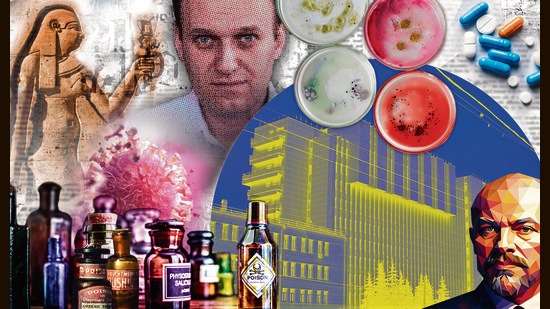
Shroom for improvement: Fantastic fungi are altering our world
1 month ago | 20 Views
There really is some magic unfolding, underneath the toadstool.
It is not the magic of the fairytales and children’s rhymes, but it’s there all the same: the more science attempts to unravel the world of fungi (those fleshy living things that are famously neither plant nor animal), the wilder the details become.
Mycelium, the networks of fine thread-like root structures that power these species, is now believed to powerfully influence forests. The enzymes and organic acids they produce, including cellulase and amylase, can metabolise substances ranging from radioactive waste to acids containing gold.
And this barely scratches the surface.
Take, for instance, the numbers: Only between 0.5% and 5% of fungus species in the world have been described. Of these 150,000 known species, some are microscopic and airborne and live in and on humans (including on the scalp and skin, where they subsist on keratin without harming living tissue); others are aquatic (Halophytophthora) and live in the oceans. Even the ones we forage for and add, sauteed, to a meal, aren’t really understood.
“Mushrooms are the portion of a fungus generally visible to us. They are essentially the fruiting bodies or reproductive structures of certain fungi,” says environmental microbiologist Shrey Gupta, who works to preserve local fungi in India.
One thing humans did figure out, early on, was that mushrooms could hold magic of a different kind. Fungi have been used as “mood elevators” for centuries. Mayan stone sculptures in Guatemala dating to about 500 BCE show bulbous mushrooms with faces engraved on them. The stones were likely associated with rituals involving hallucinogenic fungi and fertility rites. In Spain, the Selva Pascuala mural dating to 4000 BCE depicts fungoid figures believed to represent mood-enhancers too.
Today, the focus is shifting. Science is attempting to understand, for instance, what makes the world of fungi so diverse.
“Part of the reason there is such diversity,” says M Sudhakara Reddy, a professor of biotechnology at Thapar University in Patiala and secretary of the Mycological Society of India, “is that fungi are able to thrive in the most inhospitable environments. They are extremely adaptive. They can break down complex organic molecules, detoxify toxic metals such as cadmium, copper and cobalt by releasing enzymes and metal-binding proteins that reduce their toxicity. The fungi then simply feed on the sugars and nutrients created as a by-product.”
With advances in molecular biology, such properties are being isolated and put to new uses.
Some fungi are being used to help create new-age biodegradable electronic circuitry (think of a circuit board base that one can simply drop out of a window, to melt into the soil in 11 days); treat acute depression (psilocybin, one of the compounds that makes some mushrooms psychotropic, is finding medical applications); help grapevines fight rising temperatures (by reaching further for water than their roots can, and passing on the moisture); and even create nanoparticles that help with drug delivery and medical imaging.
“From their role in carbon sequestration and soil regeneration to their potential in providing sustainable materials and alternative protein sources, they have the potential to help foster resilience in our ecosystems,” says Gupta.
It is their ability to draw harmful pollutants from air, water and soil that excites him most, he adds. “Research on the use of mycelium for biodegradable packaging and construction materials, and research into their medicinal properties, is crucial. But alongside these, what also excites me is helping demystify fungi,” he says.
In that spirit, let’s return to why fungi are neither a plant nor animal.
They were, in fact classified as the former, until the mid-20th century (since many grow in soil, have cell walls and are immobile). But in truth, fungi have cell walls like plants do (animals have cell membranes), but cannot perform photosynthesis and cannot create their own food, which means they are not technically plants. They are not technically animals because of the aforementioned cell wall, and because while animals ingest their food, fungi absorb their nutrition.
All of which leaves fungi with some unique traits. They have the ability to secrete enzymes to make a meal out of surrounding matter; they can absorb nutrients and pass them on to host plants. These unusual qualities are now being leveraged in new innovations. Take a look.
Mushroom circuit boards

It looked like a fluffy mat. It smelled funny, and seemed as if it would peel off, like a skin.
Researchers at Austria’s Johannes Kepler University were peering at the growth of a dense network of fibres that had sprouted atop moist birchwood shavings. They had inoculated the shavings with the fungi Ganoderma lucidum a few weeks earlier, while researching mushroom-based thermal insulation materials.
“When we peeled off the mat-like skin, it appeared hardy but bendy. We wondered, could it be used in flexible electronic circuit boards?” says Martin Kaltenbrunner, professor in the physics department at the university, and head of the LIT Soft Materials Lab and Soft Matter Physics.
If that seems like an odd leap, well, soft, flexible electronics for use in wearable devices (such as health monitors and radio-frequency identification or RFID tags) are a key focus area for Kaltenbrunner and his team. A dream often discussed in their lab has involved the hope that they would one day find a biodegradable material to replace the polymers and paper currently in use in these bendy circuit boards.
Now that they had this mushroom to assist, Kaltenbrunner roped in researchers from the university’s Institute of Polymer Science, and together they used the mycelium skin as the base of the world’s first mushroom-based flexible electronic circuit board.
That was in 2021. Their paper on it was published in the journal Science Advances in November 2022. The biodegradable board has so far been used to power a sensor. And the lab has numerous other reasons to be celebrate.

First, their board breaks down completely in about 11 days. And it does not require the processing and vast quantities of water needed to make both polymers and paper.
Growing the fungi is neither cost- nor energy-intensive. It doesn’t take very long (the mycelium matures in friendly lab conditions, in about four weeks). And the mushroom in question sprouts quite happily on waste from the timber industry.
“The mycelium skin can withstand temperatures exceeding 200 degrees Celsius. So, it’s stable and doesn’t catch fire,” Kaltenbrunner says.
The team now aims to achieve a first phase of scaling up, in collaboration with private companies. “We’ll also be looking into making the mycelium skin more compatible with more standard printed circuit-board techniques. We’re in touch with manufacturers in Austria,” Kaltenbrunner says.
.
Chatter in the undergrowth

There are scientists who argue that, if the forest is a “super organism”, the fungal connections that serve as essential carriers of nutrients and information, could be considered a “wood-wide web”.
That’s a rather awkward allusion, and one that does a disservice to fungi, fungal biologist Nicholas P Money of Miami University has said.
Fungi are, after all, constantly learning, sensing, making decisions. “This rich behavioral repertoire allows (them) to adapt in real time to changes in environmental circumstances. Our internet shows none of this inherent flexibility. It is a network of pathways that generates nothing on its own,” he wrote, in a 2021 essay in the journal Fungal Biology.
Research indicates that the spore-producing organisms do also communicate in some form, as they grow, heal and respond to chemicals and changes in the air, soil, water and in plants. This communication manifests as underground electrical and chemical impulses within mycelium networks.
Until as recently as last year, however, research on these signals was limited to studies performed on fungi grown in the lab. In a new study conducted on fungi in situ, on a forest floor in Japan, researchers at Tohoku University, Nagaoka College and Kyoto University collected data on underground electric chatter in the wild.
Their study, published in the journal Fungal Ecology last year, was based on a three-day experiment that involved attaching electrodes to six mushrooms of the species Laccaria bicolor.
Initially, the attached electrodes exhibited few electric spikes. Then it rained, and the signals started to fluctuate and grow in intensity. This signalling was particularly strong between mushrooms that were spatially close, and it demonstrated directionality, says forest ecologist Yu Fukasawa of Tohoku University, lead author of the paper.
The next step would be to study these impulses further and determine impact, such as whether they alter the physiology of mycelial cells, and to study whether communication leaves the mushroom community and is transmitted to nearby flora. “This is one of the goals of our research,” Fukasawa says.
Under lab conditions, research has shown that some fungi appear to emit information about events such as an insect attack, prompting the release of defensive compounds in plants.
Scientific work in this field is hindered by the complexity of the fungal system, Fukasawa says. “Mycelial networks are intricate and complex, existing in a dynamic and often inaccessible environment — the soil. This complexity makes controlled experiments difficult and the interpretation of results potentially confounding,” he adds.
It doesn’t help that funding is limited. “The study of electrical signalling in mycelial networks, while fascinating,” Fukasawa says, “is somewhat esoteric and its practical applications are not yet fully understood.”
.
Spinning gold

Mushrooms are being used in a Rumpelstiltskin-like manner, to churn out gold nanoparticles, in experiments conducted in Goa.
Now, fungi have been used to turn chloroauric acid into gold nanoparticles since the 1990s. But researchers at the University of Goa have shown that a type of mushroom that grows widely on termite hills in that state (Termitomyces heimii) can revolutionise how this is done, allowing a single mushroom to yield far more of the particles, far more easily.
Their study was published in the journal Geomicrobiology in February.
First, a look at why this matters. Gold nanoparticles are in great demand in biomedicine and biotechnology, because they have the ability to slip through barriers such as cell membranes. In doing so, they have revolutionised drug delivery. The nanoparticles also absorb and scatter light in unique ways, and have enhanced thermal conductivity, which makes them vital in cutting-edge diagnostic machines and tests.
Their antifungal and antibacterial properties make them useful in luxury cosmetics as well, where they feature in creams, lotions, hair products, lipsticks and deodorants.
These nanoparticles were once synthesised using complex and expensive chemical processes. Then it was found that a wide range of mushrooms, easily and inexpensively available, could secrete enzymes that break down gold ions to produce nanoparticles. This made the process more sustainable, and in addition, the nanoparticles turned out better: more stable, with a longer shelf life and increased effectiveness.

Now, Sujata Dabolkar and Nandkumar M Kamat of the Goa University have taken another step forward, using pellets made from isolated cultures drawn from a single Termitomyces heimii shroom, rather than extracts from several mushrooms.
While they work, they needn’t look far for a snack. Known locally as roen olmi (Konkani for termite-hill mushroom), the mushroom is a prized delicacy in Goa too.
.
Grape expectations

About six years ago, vineyard owner Michael Voelker began noticing specks of white in the soil of his 7.5-hectare vineyard in Franken, Germany. The earth seemed crumblier, wetter, with a darker hue. It smelled like a forest after the rain.
“The mycorrhizal fungi had shown up,” he says.
About three years before this, Voelker began experimenting with “good soil practices”. He stopped tilling, to begin with. He introduced compost that contained extracts of fermented deadwood forest soil.
He wanted his family’s vineyard to be as healthy as it could be; as it turned out, he also took a step towards making it more heat-resistant, just as average temperatures were beginning to rise in the region.
Here’s how it works: Voelker ’s family has co-owned the 2NaturKinder winery for 181 years. He currently runs it with his wife Melanie Drese. And until recently, the vines were able to fend for themselves.
Now, particularly in summer, as groundwater levels dwindle, the vines’ thick, woody roots are unable to reach the available water. This is where the white dots come in. They are the mushrooms of mycorrhizal fungi, which form symbiotic relationship with host plants — drawing carbon and nutrients from the plant, and in exchange, using its strand-like network of hyphae to transmit water (among other things, including nutrients) back to the host.
Experiments along these lines are also being conducted in Chile, where the Vitis vinifera (or common grape vine) is of great economic importance.

“Tilling frequently destroys mycorrhiza. When we stopped doing it, the soil loosened up, earthworms showed up, and then the fungi did,” Voelker says.
Voelker swears that even his wine has improved. “There are increased amino acids in the juice, which contribute to healthier fermentation. The wines are more complex and richer in flavour. This happens when the roots pick up more nutrition from the soil, which happens when the soil is alive,” he says.
.
A new high, a fresh start

In many ways, cancer treatment is like an iceberg. The tip is the chemotherapy, radiation and surgery. What lies beneath, often unseen, is a mountain of anxiety, depression and fear.
In his two-decade-long practice, Washington-based oncologist Dr Manish Agrawal realised that although cancer patients live much longer today, often remaining in remission, many were not recovering emotionally from their diagnosis and its implications.
“The quality of life degrades and there’s that nagging, crippling fear around death and losing control. Because of this, after a point, I started to feel burnt out, because I felt I was not able to really help my patients retake control of their lives,” he says.
According to a study based on Japanese health-insurance claims data, published in the journal Psycho-Oncology in 2020, up to 15% of cancer patients are diagnosed with major depressive disorder (MDD).
This is where psilocybin — the psychoactive compound found in certain mushrooms — comes in. The naturally occurring compound activates a sub-family of serotonin receptors, to bring about non-ordinary states of consciousness.

In clinical trials conducted in recent years, psilocybin-assisted therapy (PAT) had shown to be effective in addressing MDD, but it drove the cost of therapy up and was largely considered unfeasible. Now, Dr Agrawal, along with researchers from a range of institutes, including Harvard Medical School, McGill University and University of Geneva, have begun testing psilocybin-assisted group therapy instead.
The results of their phase two trials, conducted between 2020 and 2021, were published in the journal Cancer. In the study, 30 participants (nine men and 21 women; 14 of them with curable cancers and 16 with non-curable cancers) were administered a 25 mg dose of synthesised psilocybin orally once during an eight-week period, and then proceeded with group therapy and one-on-one sessions with a therapist.
About 50% of the patients showed a full remission of their depressive symptoms after the eight-week treatment, as measured by the Montgomery–Åsberg Depression Rating Scale (which looks for apparent sadness, inner tension, reduced appetite, difficulty concentration, inability to feel emotions, pessimistic thoughts and suicidal thoughts, among others).
“My theory is it disrupts habit. Psilocybin has an afterglow period of enhanced neuroplasticity for up to 30 days, and this gives us a critical window, for new learning and to change how we think and behave,” says Dr Ron Shore, a psychedelics research scientist and assistant professor of psychiatry at Queen’s University in Kingston, Canada.
A big aspect of this trial was not just the taking of psilocybin, administered as a pill, but also sustained group psychological support, Dr Agrawal adds. “A lot of grief, hidden memories, sadness and other feelings tend to come up. The perspectives one walks away with are then discussed in follow-up therapy sessions, and typically help to work through MDD.”
Phases three and four will involve randomised trials (psilocybin versus a placebo) and two doses of the synthesised psilocybin, rather than one. After that, it will be time to apply to the US Food and Drug Administration (FDA) for permission to commercially roll out the therapy.
“Cancer treatment research tends to focus more on the physical. But the psycho-spiritual state of patients is also important,” Dr Agrawal says. “Imagine going through life plagued by death dread and depression. The hope is that, in the long run, psilocybin will help us overcome that.”
Read Also: battling the resistance: a wknd interview with dr abdul ghafur
















